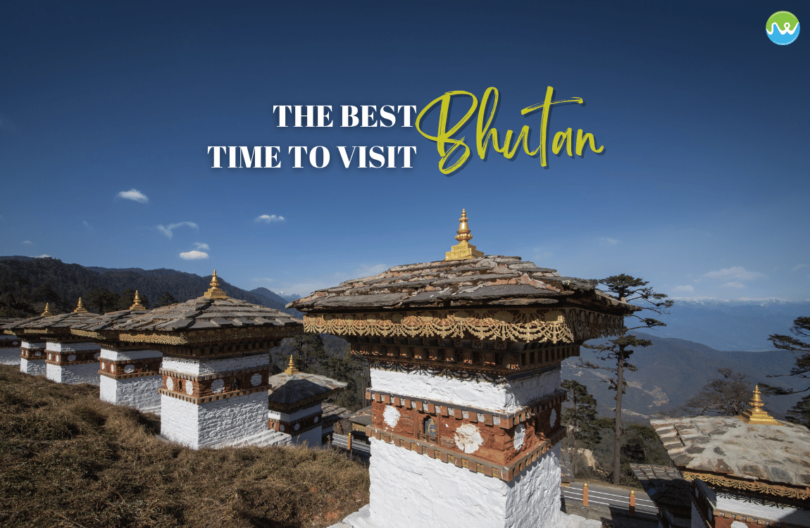Have you ever wondered why Bhutan is referred to as the Land of Thunder Dragons? What makes this Himalayan kingdom so uniquely captivating that it earns such a formidable title? Well, it is because of its dramatic and awe-inspiring natural landscape, which is often accompanied by the roaring sound of thunderstorms echoing through its valleys and mountains. This evocative name reflects the country’s profound connection with nature and its cultural heritage, where dragons are considered powerful and sacred symbols. As you contemplate the majesty of Bhutan, choosing the best time to visit Bhutan is crucial to experiencing its unique beauty and cultural richness to the fullest.
The kingdom’s climate varies significantly with the seasons, each offering its own charm. The spring months of March to May are perfect for those seeking to witness Bhutan in its most colorful splendor. During this time, the valleys burst into a riot of colors with blooming rhododendrons and vibrant prayer flags fluttering in the crisp air. The pleasant temperatures and clear skies make for excellent trekking and outdoor exploration, allowing visitors to fully immerse themselves in the country’s stunning landscapes and rich traditions.
Alternatively, the autumn months of September to November provide another exceptional opportunity to experience Bhutan’s beauty. The weather in Bhutan during this period is typically dry and clear, offering panoramic views of the Himalayas and ideal conditions for trekking and sightseeing. The annual festivals, or tshechus, held in various monasteries across the country, add a vibrant cultural dimension to your visit, with traditional dances and rituals that showcase Bhutan’s living heritage. Whether you choose the blooming spring or the clear autumn, timing your visit to coincide with these ideal conditions will ensure a memorable and enriching experience in the Land of the Thunder Dragon.
Explore More: Best Places to Visit in Bhutan
September to November: Autumn Gold

September marks the beginning of one of the most favorable and best time to visit Bhutan. As the untimely monsoon rains recede, the country transforms into a vibrant landscape of clear skies and lush greenery. This period, extending through November is often considered the best season to visit Bhutan for several reasons:
- Weather in Bhutan: The temperature during these months is moderate, ranging from 10°C to 23°C. The days are pleasantly warm, while nights are cool and comfortable. It’s the ideal time for outdoor activities and sightseeing.
- Clear Skies: With the monsoon season ending, the skies clear up, offering breathtaking views of the Himalayan peaks. This is the best time for photography enthusiasts and trekkers looking for panoramic vistas.
- Bhutan Festivals: Some of Bhutan’s most significant festivals occur during this period. The Thimphu Tshechu, usually held in September or October, is a major draw for visitors. This three-day festival showcases Bhutan’s rich cultural heritage through masked dances, music, and religious ceremonies.
- Trekking in Bhutan: The clear weather and moderate temperatures make this an ideal time for trekking. Popular routes like the Druk Path Trek are at their best during these months.
- Bhutan Flora and Fauna: The post-monsoon period sees Bhutan’s landscapes burst into life. Wildflowers bloom across the valleys, and it’s an excellent time for birdwatching.
December to February: Freezy Winter

While winter brings colder temperatures to Bhutan, it also offers unique experiences that make it an attractive time for certain travelers:
- Bhutan Temperature: Temperatures can drop significantly, especially at night, ranging from 9°C to 17°C during the day time, but these can drop to -6°C to 5°C. However, the days are often sunny and clear, providing excellent visibility.
- Snow-capped Mountains: The Himalayan peaks are at their most majestic during winter, covered in snow and offering spectacular views on clear days.
- Black-necked Cranes: Winter is the time when the rare black-necked cranes migrate to Bhutan’s Phobjikha Valley. Bird enthusiasts flock to the country to witness this natural spectacle.
- Fewer Tourists: With colder temperatures, there are fewer visitors, allowing for a more intimate experience of Bhutan’s attractions and culture.
- Winter Festivals: The Trongsa Tshechu in December and the Punakha Drubchen and Tshechu in February/March are significant winter festivals that showcase Bhutan’s rich traditions.
- Lower Altitude Trekking: While high-altitude treks may be challenging, lower-altitude treks in central Bhutan like the Sinchula Winter Trek and the Nabji Korphu Winter Trek can be enjoyable during this period.
Recommended Read: Tiger’s Nest Monastery Guide
March to May: Spring Blooms

As winter transitions into spring, March becomes another best time to visit Bhutan, as it offers a very unique blend of experiences:
- Weather in Bhutan: Temperatures start to rise, ranging from 11°C to 22°C, making it more comfortable for outdoor activities.
- Rhododendron Blooms: Bhutan’s famous rhododendron forests begin to bloom, painting the landscapes in vibrant colors along with other wildflowers dotting the countryside.
- Paro Tshechu: One of Bhutan’s largest and most popular festivals, the Paro Tshechu, usually takes place in March or April, drawing visitors from around the world.
- Pre-monsoon Clarity: The air is still clear before the onset of the pre-monsoon haze, offering good visibility for mountain views and photography.
Considerations and Challenges

While September to March is generally the best time to visit Bhutan, there are some factors to consider:
- Winter Cold: If you’re planning to visit Bhutan from December to February, be prepared for cold temperatures, especially at night. Proper winter gear is essential.
- Limited Accessibility: Some high-altitude areas may have limited accessibility during winter due to snow.
- Festival Crowds: During major festivals, popular sites can get crowded, and accommodation may be in high demand. Early booking is recommended.
- Varying Weather: Bhutan’s weather can be unpredictable, especially in the mountains. Be prepared for sudden changes, regardless of the season.
Why Choose Specific Months?
- September-November: This is the best time to visit Bhutan for those who want perfect weather, clear mountain views, and the chance to experience major festivals without extreme temperatures.
- December-February: Best for travelers who enjoy winter landscapes, are interested in unique wildlife experiences like black-necked crane viewing, and don’t mind colder temperatures.
- March-May: Perfect for those who want to experience the beginning of spring, see rhododendron blooms, and participate in the famous Paro Tshechu.
Read more: Reasons to Visit in Bhutan
The best time to visit Bhutan from India largely depends on your personal preferences and what you hope to experience. From September to March, each month offers its unique charm and attractions. Whether you’re drawn by the clear autumn skies, the winter wonderland, or the spring blooms, Bhutan has something special to offer.
Remember, while the weather in Bhutan and festivals play a significant role in deciding when to visit, the true magic of Bhutan lies in its timeless culture, warm hospitality, and breathtaking landscapes – elements that remain constant throughout the year. No matter when you choose to visit, Bhutan promises an unforgettable journey into a world where tradition and nature coexist in perfect harmony.

FAQs
Which is the best month to visit Bhutan?
The best time to visit Bhutan is March to May and September to November for clear skies and festivals like Paro Tshechu. Don’t miss trekking to Tiger’s Nest Monastery during these months!
Plan your trek to the monastery now!
How many days are enough in Bhutan?
A 7-day trip to Bhutan is an ideal duration for travelers seeking a balanced experience of the country’s rich cultural heritage, stunning landscapes, and serene spirituality. This length of stay in Bhutan allows visitors to explore the best places to visit in Bhutan like Tiger’s Nest Monastery, Thimphu, Punakha, and others without feeling rushed.
Is Bhutan cheap or expensive?
Bhutan can be expensive due to the mandatory Sustainable Development Fee for tourists along with a compulsory tour guide. It is also mandatory for tourists to book accommodations in hotels that are at least 3-star, however, a trip to Bhutan offers unique experiences, and you cut down on costs when traveling with a tour operator. Explore Bhutan tour packages—plan your visit!
Is a Bhutan visa free for Indians?
Yes, Bhutan offers visa-free entry for Indians, but Indians need to carry a valid passport or voter ID in order to obtain a Bhutan entry permit at Bhutan’s Immigration Office.
Learn more about the Bhutan Entry Permit now!
How to plan a Bhutan trip from India?
Start by securing your entry permits at Phuentsholing or Paro, and plan stops at Tiger’s Nest Monastery, Thimphu, and Punakha.
Create your seamless Bhutan trip today!
Take a trip to the Land of Thunder Dragon with our Bhutan group tour package.







